Optical, hyperspectral, and x-ray imaging, along with spectroscopy, are used for different types of food inspection, from grading meat to spotting foreign material.
By Albert Tu
A decade ago, food supply was not an issue for most of the world’s population, but today the world is facing a food crisis. Multiple factors have contributed to the problem, including recent supply chain issues, delivery and labor shortages, and conflicts around the world. In addition to maintaining a steady supply of food, producers are increasingly working to create sustainable processes that result in less waste while maintaining quality.
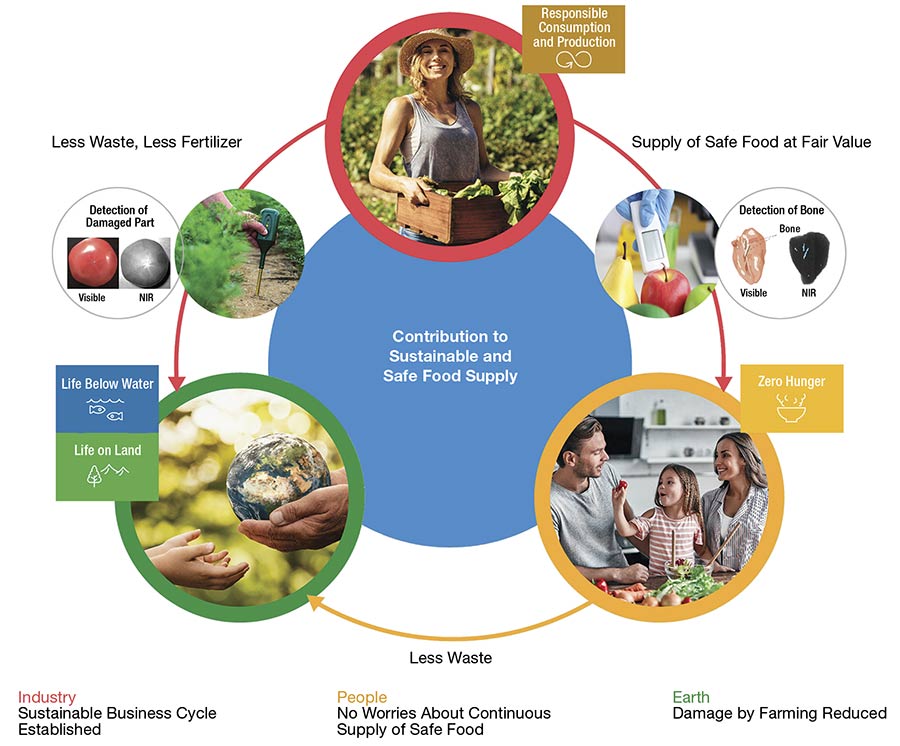
Early inspection creates safe food products and less waste of resources. Courtesy of Hamamatsu Photonics.
Providing safe, high-quality food requires inspection of food products. In the past, people relied on human senses to judge food based on its appearance, smell, and texture. But with today’s more advanced inspection methods, it is not only possible to grade products based on color, texture, moisture content, and internal features but also on contents such as fat, sugar, or even glucose level, without damaging the food product. With many inspection techniques available, optical and x-ray-based methods have been among the most efficient and reliable. There are several major ways, from machine vision to spectroscopy to hyperspectral imaging — a technique that provides both spatial and spectral information — for discovering the most efficient inspection method for a particular process.
From human to machine
A couple of decades ago, most food providers were using humans to sort food along the process line. As produce volume continued to grow, conveyor belts were used for food processing, and human vision became no longer feasible due to accuracy and cost issues. Inspectors were easily confused by similar colors and shapes, and they were unable to identify defects under produce skin or packaging. The high volume of produce traveling along conveyor belts was also a challenge.
These issues forced food providers
to turn away from manual sorting and toward automated machine vision technology instead. Machine vision offers many advantages. For example, a variety of imaging methods involving visible and nonvisible light and x-rays can be used for various levels of inspection. In addition, companies can reduce errors in food inspection and packaging before products get into the consumers’ hands, and they can also track down when and where process issues occur, saving time and money spent in determining which part of the process went wrong.
Discerning shape and size
High-speed CCD and CMOS cameras with software for in-line food inspection have been used for decades to successfully identify dents, scratches, and mold. Such cameras can also help with grading food based on color, shape, and size.
A food’s appearance creates a formidable challenge when inspecting for quality or for evidence of contamination — depending on the volume of food and the conveyor belt speed — so in-line, high-speed cameras with high resolution are needed. For more advanced inspection, different multiline cameras, such as RGB trilinear and RGB NIR quadlinear, could capture spectra simultaneously. Based on the working environment, an IP69K or higher dustproof and waterproof rating will be beneficial. The advantages of visible imaging include identifying appearance defects such as scratches and dents, and the ability to grade objects by shape and size.
Subsurface defects
Nonvisible imaging, such as shortwave infrared (SWIR) using indium gallium arsenide (InGaAs) cameras, provides information that typical CCD or CMOS cameras cannot. Nonvisible imaging typically uses InGaAs cameras due to their high sensitivity from 900 to 2500 nm. Unlike decades ago when InGaAs fabrication techniques were in their infancy, manufacturers today offer high-resolution, high-speed InGaAs cameras with no cooling required.
The advantages of nonvisible imaging include the capability to detect moisture content such as bruising on produce, along with discerning foreign objects such as rocks in similarly colored
food such as coffee beans or rice. Nonvisible imaging can also image beneath thin surfaces such as plastic and paper, or inspect the quality of package sealing.
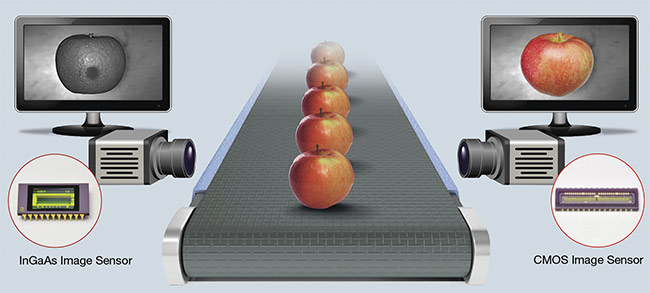
Using different wavelengths for imaging collects different information. InGaAs: indium gallium arsenide. Courtesy of Hamamatsu Photonics.
Placing both visible and nonvisible machine vision strategically in the
process line enables each to provide
different information — for use in inspecting agricultural products, for example. Based on the information provided about characteristics from appearance to internal bruising, fresh produce can be sorted and the high-quality product can be reserved for consumers, while produce with some external damage can be used in processed food or fertilizers. This process can minimize the waste of products coming from farms.
X-rays for subsurface inspection
While visible and nonvisible machine vision are used for appearance or subsurface inspection, x-ray imaging is the most reliable way to inspect for internal features. Even though x-ray imaging has been mostly known for medical
applications and baggage security, x-ray inspection is becoming increasingly necessary for checking for quality in the food industry.
Strategically placing nondestructive testing systems that use different methods could save businesses time and money and provide high-quality and safe food to consumers.
Metal detectors have often been used as a quality check for internal
food inspection, but their ability to
detect is limited to only metal objects, and their sensitivity can vary depending on the magnetic permeability and
electrical conductivity of the metal. X-ray imaging, however, can detect metals, glass, plastic, bones, and shells with very high sensitivity. X-rays can reveal the shape, size, and location of foreign objects.
In-line x-ray food inspection is carried out by moving the object on a conveyor belt while scanning line by line at very high speeds with an x-ray line-scan camera. These cameras come in a variety of lengths (up to 1 m), speeds, and resolutions to fit with the food processor’s production line and quality assurance requirements. The high-dynamic-range x-ray images are then fed to a computer, where various software programs perform automatic defect recognition.
The advantages of x-ray imaging include seeing through thick surfaces and detecting very small objects inside at high speed, and identifying objects inside packages or inspecting the quality of package sealing.
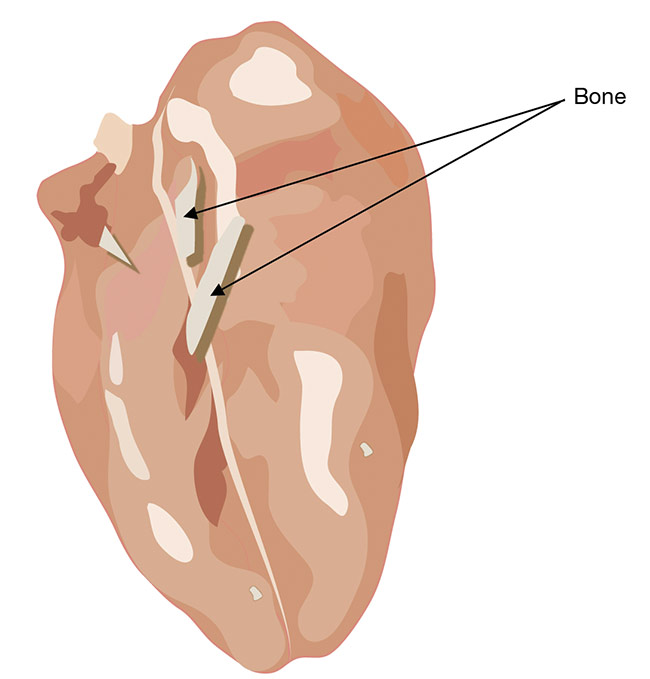
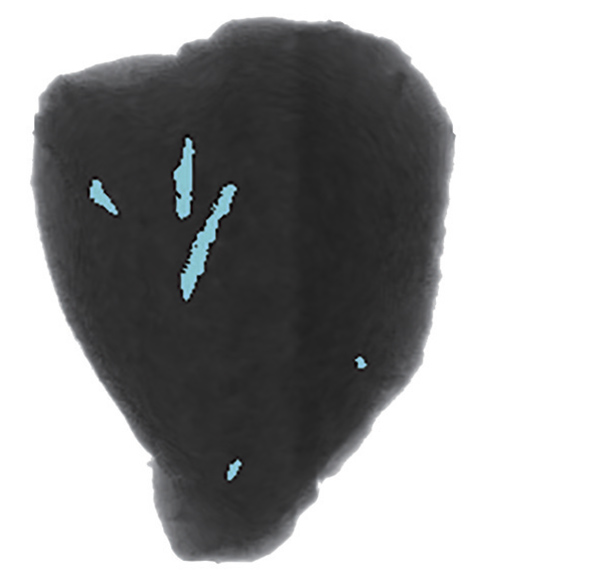
Small bones in meat or fish can be detected using x-ray imaging. Courtesy of Hamamatsu Photonics.
 Adapted with permission from References 1 and 2.
Adapted with permission from References 1 and 2.
When it comes to inspecting mixed material objects such as bones inside chicken or fish, dual-energy x-ray can be used to achieve high sensitivity.
This in-line food inspection technique
uses only a single x-ray source combined with a dual-energy x-ray line-scan camera that can detect two energy levels from the x-ray spectrum. The operator can adjust the threshold
settings, depending on quality assurance standards, and the images can
be processed in automatic defect-recognition software.
Spectroscopy for food composites
Food is a combination mainly of water, fats, proteins, and carbohydrates, together with numerous minor components. Food products’ properties — such as appearance, color, flavor, and texture — that can indicate quality
and safety depend on the molecular structure and intra- and intermolecular interactions within food systems. To identify and measure a food product’s molecular components, and thereby determine its quality and safety, food providers can turn to spectroscopy.
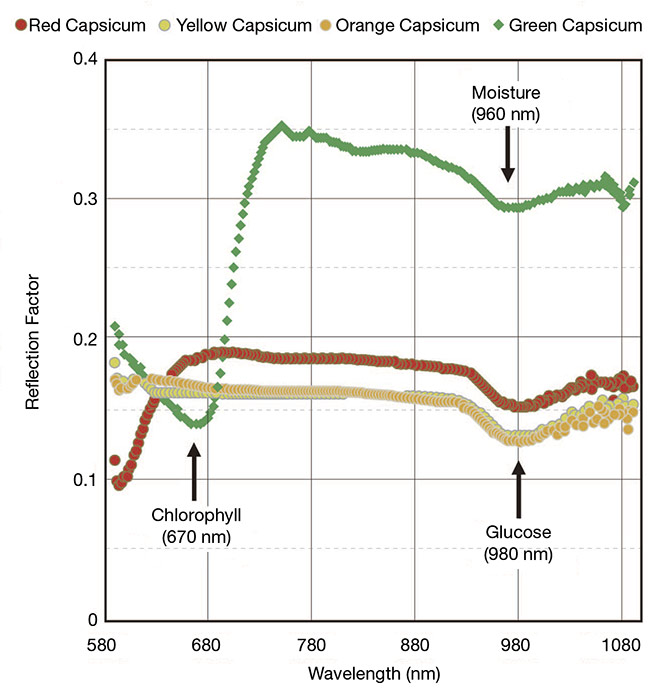
NIR spectroscopy identifies and measures components of fresh produce Courtesy of Satoru Nakashima/Osaka University
Spectroscopy is one of the most successful technologies at evaluating the quality of food based on molecular information. Instead of relying on human senses — which subjectively judge the appearance, color, and other food properties — food providers use spectroscopy to generate quantitative data. With the help of built-in spectral
libraries, spectroscopy makes it easier for food providers to identify the key contents of food, and quantified statistics can be used to measure food quality. In addition, spectroscopy requires minimal or no sample preparation, allowing rapid and on-line analysis of single or multiple samples.
Near-infrared (NIR) spectroscopy holds the key to unlocking information
about nutrients, freshness, and ripeness. Examples of food contents
detectable in the NIR spectrum are shown in the table above.
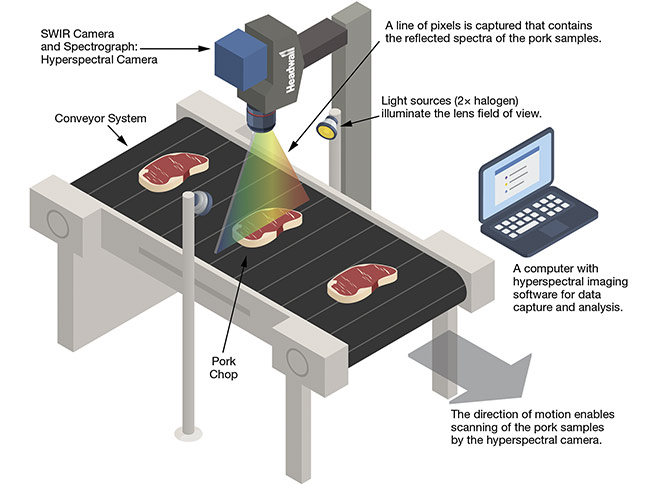
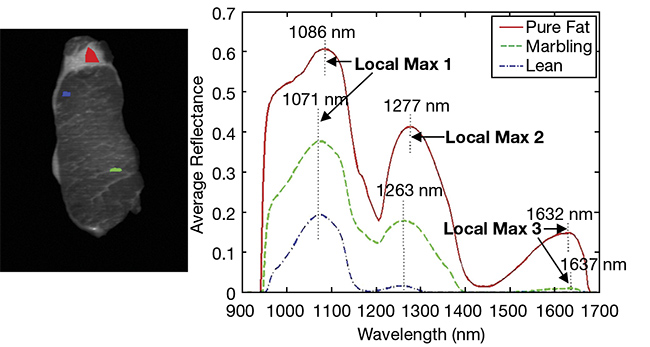
The small footprint of hyperspectral imaging sensors enables their placement at a location on an existing processing line without disrupting operations (top). An imaging system was built to rapidly scan pork chops and noninvasively predict intramuscular fat content (bottom). Courtesy of Headwall Photonics/Michael Ngadi, McGill University/MatrixSpec Solutions.
Many NIR spectrometers are
available on the market, including an NIR spectroscopy tool that combines a broadband halogen lamp into a hand-held Fabry-Pérot interferometer, with options that cover wavelengths from 1350 to 2150 nm. This device allows the user to perform either reflectance
or transmission measurements to
characterize important information about food quality with limited or no sample preparation, such as identifying the fat, protein, and water contents from dairy products.
For fruits and vegetables, determining the maturity and sugar content could not only provide information about fertilizer application in the field, but also grade the final product based on the sugar content and ripeness.
Hyperspectral imaging for sorting
Hyperspectral imaging is a technique that combines the benefits of a camera, to identify spatial information such as size and shape, with those of a spectrometer, to identify spectral information such as sugar content or moisture
content. This technique provides numerous types of information, and it is a great tool to differentiate foreign objects, identify fat content, or detect unwanted adulteration substances.
Because a hyperspectral imaging system works like using thousands or millions of spectrometers, providing
the chemical signatures from the reflected light at each pixel of an image, diffraction gratings and image sensor performance play key roles. Within each range, literally hundreds of spectral bands are collected, so that a grating that is fine-tuned for a specific application and with high sensitivity and sufficient dynamic range provides precise information while food products move along the inspection line.
SWIR hyperspectral imaging
Hyperspectral imaging systems
operating in the SWIR can also be used for grading meat, poultry, or fish based on characteristics that may not be detectable by the human eye or may not be measurable by conventional
machine vision cameras. Also, SWIR hyperspectral imaging can help to identify and quantify the chemical components of a food product, providing information such as nutrition, fat percentage, sugar level, and freshness based on the distinct wavelengths, or spectral fingerprint, of each composite analyzed. For example, a SWIR hyperspectral camera on a drone can help measure the sugar content in apples growing on a tree and forecast the grade and quality before harvest season.
Hyperspectral imaging sensors represent a powerful technology for the machine vision industry, where precision beyond conventional color is necessary. Food inspection is a key application.
Grading meat quality
Grading meat quality involves numerous factors, and fat is always one of the two most important ones. Marbling could be inspected in multiple ways, while identifying or qualifying a large amount of meat could be made easier by using hyperspectral imaging. Hyperspectral imaging could identify parts that are pure fat, that contain marbling, or are lean. It is also capable of recognizing whether bone chips are inside the meat.
Creating a sustainable business cycle for food providers is currently difficult, involving limited supplies and other supply chain issues. Avoiding more waste of resources before, during, or after the process could be the key. Strategically placing nondestructive testing systems that use different methods could save businesses time and money and provide high-quality and safe food to consumers.
Meet the author
Albert Tu is a marketing engineer for Hamamatsu Corp. in Bridgewater, N.J., specializing in industrial applications. After graduating from college, Tu held positions as an electrical engineer, a field applications engineer, and a product manager in high-tech industries. He then returned to school and received a master’s degree from the University of Texas at Austin. With over 10 years of hands-on experience in product development and new technology implementation, he currently provides insights to customers to help them find the right solution for their technology; email: atu@hamamatsu.com.
Acknowledgments
The author would like to thank Andrew Fay, John Gilmore, Stephanie Butron, and Maridel Lares of Hamamatsu Corp.; Toshi Atsumi and Kunihiko Tsuchiya of Hamamatsu Photonics K.K.; and Ross Nakatsuji of Headwall Photonics.
References
1. H. Ishizawa. Application of the infrared radiation to food safety. The Illuminating Engineering Institute of Japan, www.jstage.jst.go.jp/article/jieij/94/12/94_KJ00006773151/_pdf.
2. T. Tanabe et al. (1995). Internal
quality measurement of tropical fruits by near infrared spectroscopic technique. J Soc Agric Struct, Japan, No. 67, pp. 1-24, www.jstage.jst.go.jp/article/sasj1971/26/3/26_3_153/_pdf.